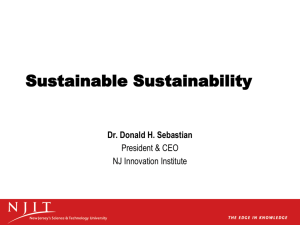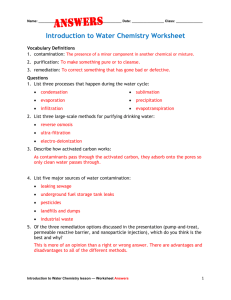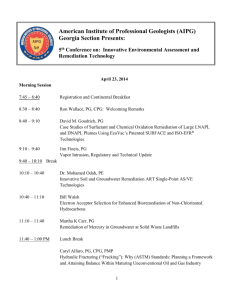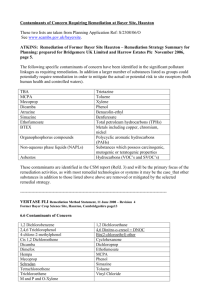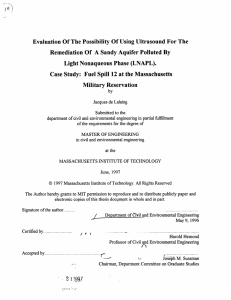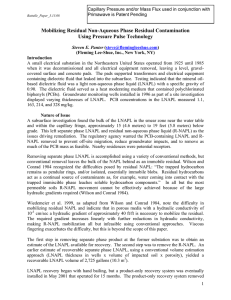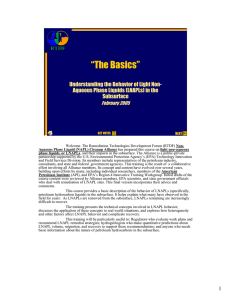An Evaluation of Natural Source Zone Depletion Versus
advertisement
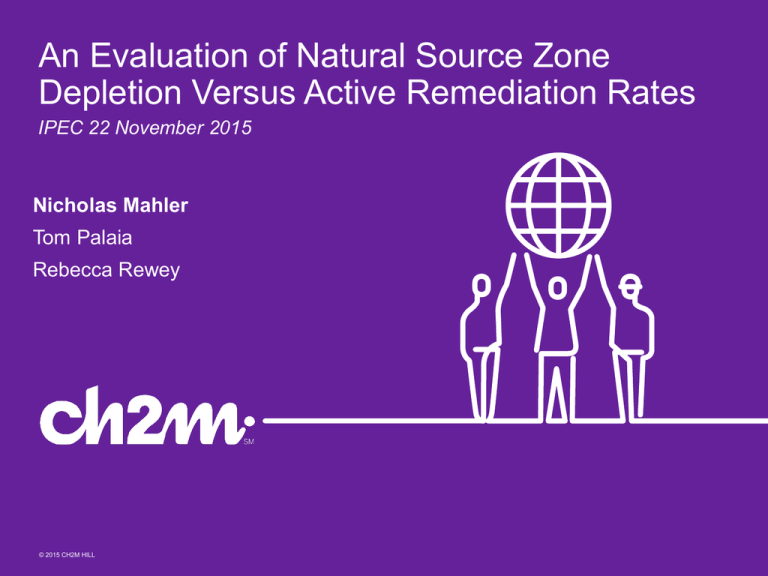
An Evaluation of Natural Source Zone Depletion Versus Active Remediation Rates IPEC 22 November 2015 Nicholas Mahler Tom Palaia Rebecca Rewey © 2015 CH2M HILL Drivers and Objective • Measurement of natural source zone depletion (NSZD) rates (aka loss rates) of petroleum hydrocarbon LNAPL is an emerging science – To receive broader support, it is important to ground-truth the results • To provide perspective, a survey consisting of 51 diverse sites/systems was performed to improve understanding of rates of remediation (in consistent units) for various petroleum remediation approaches • This presentation will compare NSZD remediation rates to active remediation systems, and show that measurements of NSZD rates are comparable 2 Agenda • Conceptualization of LNAPL in Subsurface • Overview of NSZD • Rates of NSZD as Measured by CO2 Efflux • Rates of Active Remediation • NSZD vs Active Remediation Rates • Conclusions 3 LNAPL Setting • LNAPL exists in 4-phases • Pore fluid profile often at <30% pore volume 4 LNAPL Quantification • Integrating specific volume over an area provides an estimate of the volume of LNAPL in the subsurface – A 1-ft mobile LNAPL smear zone profile with specific volume of 0.05 ft3/ft2 roughly equates to 16,000 gallons of LNAPL per acre (gal/ac) • Removal of 5,000 gallons from this area, reduces the in situ LNAPL volume by 30% – Reduces in situ LNAPL pore fluid saturations in smear zone profile to a maximum equal to the residual LNAPL saturation – Non-recoverable, immobile fraction will remain in situ 5 Natural Source Zone Depletion - Petroleum 6 Natural Source Zone Depletion - Petroleum • LNAPL is degraded by the intrinsic processes of volatilization, dissolution, and biodegradation • Results in significant and measurable losses of source material 7 Carbon Dioxide (CO2) Efflux Measurements • Estimated NSZD (aka LNAPL loss) rates based on stoichiometric conversion of sitewide CO2 efflux measurements • 8 diverse sites (E-Flux CO2 Traps – 3 sites and LI-COR® 8100A soil flux system – 6 sites) – Total of 86 CO2 trap and 290 LI-COR® event-locations E-Flux CO2 Trap • Site conditions included: – – – – – – Natural gas well site Operating gas plant and compressor station Pipeline Terminal Railyard Remote maintenance camp LI-COR® 8100A Soil Flux System • Urban and rural areas with predominantly pervious, but variable ground cover • Consolidated and unconsolidated subsurface soil 8 Example Results from a NSZD Evaluation • Collected CO2 efflux measurements • Corrected for background • Performed stoichiometric conversion • Plotted NSZD rates • Integrated the results to estimate a sitewide NSZD rate • Sites with multiple rounds of measurements were seasonally adjusted to estimate an annual rate 9 Summary of NSZD Rates NSZD Rate (gal/ac/yr) 10,000 NSZD Median = 700 gal/ac/yr 1,000 100 10 1 1 2 3 4 5 6 7 8 Site Number • Note: Recall a site with LNAPL specific volume of 0.05 ft3/ft2 contains 16,000 gals/ac. 10 Summary of NSZD Rates Volume per acre (gallon/acre) • Recall: 1-ft mobile LNAPL smear zone profile with specific volume of 0.05 ft3/ft2 roughly equates to 16,000 gallons of LNAPL per acre (gal/ac) 20000 18000 16000 14000 12000 10000 8000 6000 4000 2000 0 0 0.2 0.4 0.6 0.8 1 1.2 Smear Zone Thickness (ft) • Removal of 700 gallons per acre equates to less than an inch removal, with the same assumptions 11 Assessment of Comparable Rates of Remediation • Surveyed projects to compile real site monitoring data • 43 systems LNAPL Skimming Groundwater drawdown-enhanced Skimming Bioventing/Biosparging Soil Vapor Extraction Air Sparging/Soil Vapor Extraction Multiphase Extraction Total Number of Active Systems in Survey = 6 5 4 5 10 13 43 • Sites in survey include a variety of: – – – – petroleum products source zone dimensions remedial design bases operation and maintenance routines (i.e., zones, pulsing, etc.) Treatment Area Size (acres) Total Volume Removed (gallons) Mass Removal Rate (pounds/year) Years of Operation (years) Remediation Rates (gallons/acre/year) 12 Median Range 2.0 4,500 7,339 5.0 1,057 0.1 - 108 18 - 6,000,000 4 - 5,000,000 0.6 - 24 0.1 - 11,790 Active Remediation Rate Survey Results 13 Comparison of Median Rates of Remediation Comparison of Rates Remediation Rate (gal/ac/yr) 10,000 NSZD Median = 700 gal/acre/yr N=5 1,000 100 N=4 N=5 N=13 N=10 N=6 10 1 • Survey indicates that NSZD rates fall within the range of other remedial approaches 14 Remediation Rate (gal/ac/yr) Evaluation of Early and Late Stage Rates 10,000 NSZD Median = 700 gal/ac/yr 1,000 100 10 1 Early Stage Median Median Late Stage Median • Midway into remediation, NSZD may become stronger than some remedies • Note: 10 of the 13 MPE systems had no difference in early and late remediation rates, thus were excluded from this early/late data sets 15 Approximate Efflux Monitoring Costs • LI-COR soil flux system – Rental ~$1,700/month for the first month and ~$900/month for subsequent months – 20 beveled 8” PVC collars ~$300 – Mobilization, 8 hrs onsite/visit, 2 field technicians – install collars and perform four rounds of daily measurements – ~$500/location • E-Flux CO2 traps – Field components (~$320/location) – CO2 and 14C analysis of traps ~$1,700/location – Two site visits, start and end of 2 week deployment period (install and retrieve/ship traps, 4 hrs onsite, 1 field technician) – ~$2,000/location 16 Conclusions • In general NSZD rates measured using CO2 efflux methods are reasonable – They fall within the spectrum of the surveyed remedial systems (~200-4,000 gal/ac/yr) – Are consistent with plausible rates of remediation for sites with >10,000 gal/ac present in the subsurface • NSZD rates are significant and are competitive with remediation rates of some active systems • There appears to be a point during remediation when the effectiveness of active remediation may fall below NSZD – The NSZD rate is a useful metric for optimization of active remediation 17 Thank You Nicholas Mahler Nicholas.Mahler@ch2m.com (720) 286-3103 © 2015 CH2M HILL

